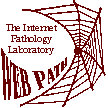What kind of genetic abnormality is most likely to be present?
The appearance of such findings so early in life suggests that this could be an autosomal recessive disorder, given that there are no significant structural defects. Most autosomal recessive conditions involve the absence of an enzyme.
What specific genetic abnormality is present?
There is a lack of the enzyme hexosaminidase A.
What is the pathogenesis of this disease?
The lack of the enzyme leads to a block in a metabolic pathway that leads to accumulation of an intermediate product, GM2 ganglioside in lysosomes.
The normal lysosomal degradation of glycosphingolipids occurs by the sequential hydrolysis of single monosaccharides from the nonreducing end of the oligosaccharide, ultimately yielding ceramide, which is then hydrolyzed to produce sphingosine and a free fatty acid.
The abnormal product builds up in cells of the nervous system, particularly neurons, as shown in the images with enlarged neurons. The storage product interferes with neuronal function. The loss of neuronal function leads to neurologic deterioration with hypotonia and retardation. On funduscopic examination, the macula has increased pallor, and there is a "cherry red" spot. Death generally occurs within 18 months to 2 years of age.
What is the probability that there is no familial history for this disease?
This disease is most common among Ashkenazi Jews who have a carrier rate of 1 in 30.
Even so, autosomal recessive conditions are unlikely to occur in every generation, so a family history may still not be obtained.
What are the patterns of this disease?
The infantile form of the disease - this case.
The juvenile-onset form presents with ataxia and dementia, with death by age 10 to 15 years.
The adult-onset disorder is characterized by clumsiness in childhood; progressive motor weakness in adolescence; and additional spinocerebellar, lower motor neuron symptoms, and dysarthria in adulthood. Intelligence declines slowly, and psychosis is also common.

What is the role of prenatal testing in this case?
Tay Sachs disease is rare. It has been virtually eliminated from appearance in the population group with the highest gene prevalence (carrier rate = 1:25) because of near universal screening for it among Ashkenazi Jews (and the fact that it is restricted to such a small and easily identified group) and French Canadian people. At one point Rabbis (especially Orthodox Rabbis and Orthodox match makers) practically required Tay Sachs testing for couples as part of their pre-marriage counseling. If both people were carriers, marriage was discouraged (the match maker would tell them that they are not a reasonable match), and usually successfully. Then prenatal testing was performed for the few couples who married and were both carriers. Judaism has never been strongly opposed to abortion, especially when there are medical indications (a baby is considered a human being only following birth). Having seen the terrible suffering babies with Tay Sachs endure, and the very short lives they live, termination of pregnancy was considered far preferable. The tests can be done and results obtained to allow a medically indicated termination of pregnancy before 20 weeks gestation



